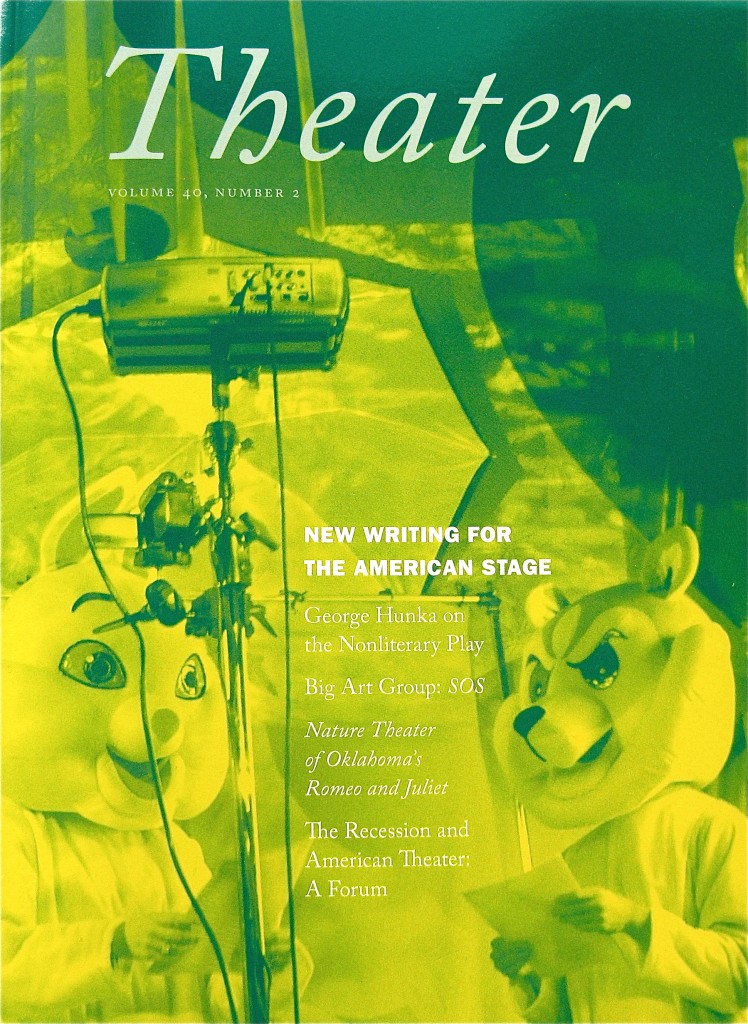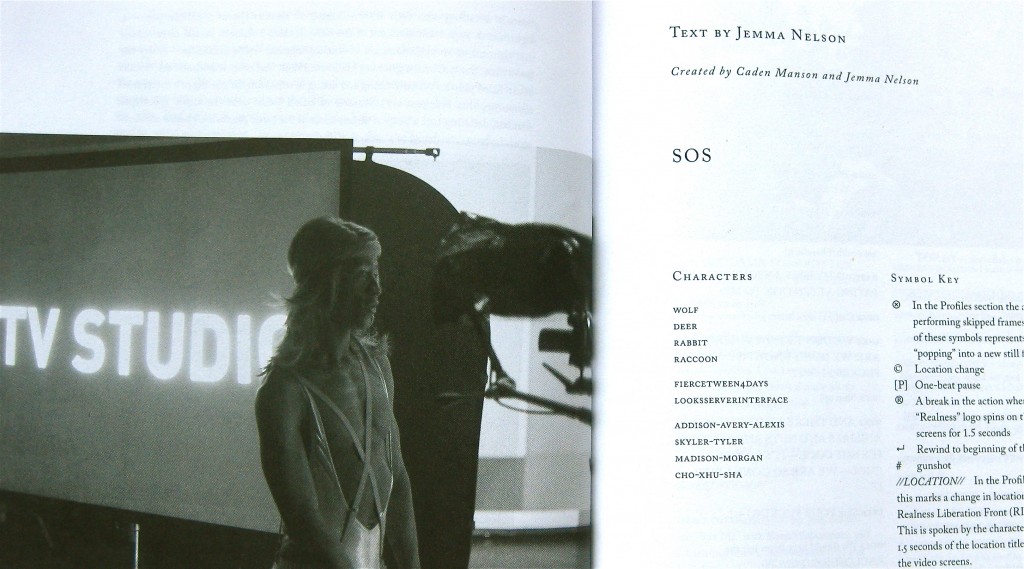
RELEASE OF THE BOOK
”TERPSICHORE IN ZEROES AND ONES.
ESSAYS ON VIDEODANCE”
THURSDAY 27th
MAY, 7PM
at CCEBA (Cultural Centre of Spain in Buenos Aires),
Paraná 1159
"Terpsichore in zeroes and ones. Essays on Videodance" is the first collection
of articles published in Spanish about this particular art form,
questioning
its own and complex grammar.
The book will be presented
to the public on Thursday 27th May at 7PM at the Cultural Centre of
Spain in Buenos Aires (CCEBA), Paraná 1159. Jointly co-edited by
Guadalquivir
Publishing House, the CCEBA and the International Festival VideoDanzaBA,
and compiled by Susana Temperley and Silvina Szperling, this publication
is the result of the first two editions of the International Symposium
on Videodance (2007/2009), also featuring some other essays, yet
unpublished
in Argentina.
The presentation will be complemented with the interactive performance
S P E A K 3. 0, by Alejandra Ceriani, Fabián Kesler and Fabricio Costa Alisedo.
Authors: Prologues by Silvina Szperling and Rodrigo Alonso.
Authors of the essays (in order of appearance): Oscar Traversa (Arg); Ivani Santana (Br);
Alejandra Vignolo (Arg); Claudia Sánchez (Arg); Alejandra Ceriani (Arg);
Laura Papa (Arg); Paulo Caldas (Br); Simon Fildes (UK); Alexandre Veras
Costa (Br); Erica Koleff (Arg); Gabriela Tropia Gomes (Br- UK); Douglas
Rosenberg (USA) Susana Temperley (Arg); Ladys González (Arg);
Ellen Bromberg (USA); Sandra Mathern-Smith (USA); Graciela Taquini
(Arg).
more info at www.VideoDanzaBA.com.ar
available online at http://www.libreriaguadalquivir.com/libros/10/Terpscore-en-ceros-y-unos-Ensayos-de-videodanza/
About “Terpsichore in zeroes and ones.
Essays on Videodance”
The richness of this publication is founded in its diversity of views, including those from
scholars specialized in disciplines close to Videodance who have made
important contributions from the fields of Semiotics, Philosophy and
Art Criticism, as well as the practice of video, cinema, digital art
and dance. And even reflections upon the use of the Internet, the
Interactive
Systems in relation to Education, AIDS and social movements. Thinkers
and artists from Argentina, Brazil, the USA and the UK converge in this
book. These essays will begin to cover an increasing need and curiosity
from researchers, students and artists, supplying information and
reflections
in Spanish which dialogue among them, in the way of a rich and bright
mesh.
Terpsichore, our Muse of the Dance, keeps on getting transformed in the 21st Century. She
dances in the cyberspace as well as in the street, on the videotape
and at the museum, in the theatre and on the screen, in the paper as
well as in life.
Other news of the International Festival VideoDanzaBA
| Call for entries 2010. Videodances and Documentaries on Dance
DEADLINE: JUNE, 15th 2010
Pieces must be registered
online at www.VideoDanzaBA.com.ar
They must be sent by regular mail up to June 15th,
2010 (postmarked date valid) to:
FESTIVAL INTERNACIONAL
VIDEODANZABA
CENTRO DE INVESTIGACION
CINEMATOGRAFICA
Benjamín Matienzo 2571 (C1426 DAU) - Buenos Aires – Argentina
Additional press material
WHO ARE WE?
Since 1995, VideoDanzaBA,
founded as Festival Internacional de Video-danza de Buenos Aires,
is a platform for divulging, learning, discussing, and developing
networks
about the artistic work around the axis body-technology in the broadest
sense.
With a strong accent on the exchange with the Latin American countries, that lead to the
establishment of MERCOSUR Videodance Circuit (CVM) and
the Latin American Videodance Forum (FLV), VideoDanzaBA
has also developed residency plans with foreign organizations such as
South East Dance (RU), among others, to increase the research
opportunities
and the artistic exchange, in a frame that encourages diversity.
In 2008, at its tenth edition, the festival widened its range to a broader arch of artistic
forms linked to videodance: installations and performances that involve
new technologies and interfaces in real time.
In 2009, thanks to the support of Iberescena, the festival presented again multimedia live
performances, with companies from Spain, Chile and Argentina. Also,
the Second International Symposium on Videodance (SIV)
“Thinking Videodance II” was held with scholars from Brazil,
Argentina and USA, among other countries.
This year 2010 –our 15th birthday- we continue with the same line. The publishing
of a book, two residencies, a project development LAB, workshops for
professionals and for members of the community, scholarships and
internships
-from our Education Department-, will add up to our usual screenings
(open call, work-in-progress, retrospectives and special screenings).
The audience access, the artistic communication and the development of the regional
production
are our major priorities.
The festival VideoDanzaBA
10 has support from:
INCAA (National Film Institute)
INT (National Theatre Institute)
CCEBA (Cultural Centre of Spain in Buenos Aires)
British Council
CIC (Research Centre on Film)
ABOUT Silvina Szperling
– Director of the Festival VideoDanzaBA
- Choreographer, video artist and curator, dance journalist.
- Director of the International Video-dance Festival of Buenos Aires.
- Coordinator of Mercosur Videodance Circuit and Latin American Videodance Forum.
- Curator and artistic co-director of Buenos Aires Contemporary Dance Festival in 2008.
Graduated from the First School of Body Expression, directed by Patricia Stokoe (1979)
and from the Dance School of Margarita Bali (1986), Silvina Szperling
has been a choreographer for both conventional and non-conventional
stages since 1985. In 1993 she started to make video-dance,
documentaries
on dance and collaborations in multimedia pieces as a video artist.
Her formation in video-dance includes the First Video-dance Workshop
for choreographers by Jorge Coscia (1883), the six-week video-dance
school by Douglas Rosenberg as a grant holder at the American Dance
Festival (1994), in addition to Director of Photography (1995, SICA,
by Rodolfo Denevi), Documentary Video (1994, Ricardo Rojas Cultural
Centre, by Andrés Di Tella), and master classes by Thierry De Mey at
the Experimental Centre of Teatro Colón (2006).
Her work in Video-dance
initiated this art form in Argentina. Her pieces Temblor,
Bilingual duetto, sistersister, SZiS
and Chámame have been screened at many festivals in her country
and abroad. Temblor won the Best Editing Prize from the National
Secretariat of Culture, and has been included at the New York Public
Library’s Dance Collection at Lincoln Center, as well as at the
Argentine
National Museum of Fine Arts’ Video Collection. Her documentaries
Danza argentina en los 60 and Escrito en el aire have been
produced through grants from the National Fund for the Arts. Between
January and March, 2000 she produced and directed the weekly TV program
Videodanza, nationally broadcast by Channel 7 Argentina. In
July, 2002 she made a residency as a guest artist at the
Video-dance
Summer Workshop at the University of Wisconsin-Madison. Her video-dance
SZiS was awarded a grant from Dance Film Association NYC and was
premiered as part of the competitive screening at the III International
Jewish Film Festival of Buenos Aires (Hoyts General Cinema, November,
2005). It was screened at Tandil Film Festival, Oberá en Cortos
(Misiones,
Argentina, 2006) and IDN Festival - Imatge, Dansa i Nous Mitjans
(Barcelona,
2007). Chámame was premiered at Alliance Française in Buenos
Aires, and has been screened at moves09 (Machester, UK), FRAME
(Porto, Portugal), agite y sirva
(Puebla, Mexico), UFBA (Salvador de Bahía, Brazil) and Dance Camera
West (Los Angeles, USA).
She is the founder and director of the International Video-dance Festival of Buenos
Aires, which has developed eleven editions between 1995 and 2009.
The Festival has been supported by public institutions such as the
National
Fund for the Arts, the National Secretariat of Culture, the City’s
Secretariat of Culture and the University of Buenos Aires, the National
Theatre Institute (INT), the National Film Institute (INCAA), as well
as private institutions such as Fundación Antorchas, the Research Centre
on Film (CIC) and Channel á, among others. Its International supports
have included the embassies of France, Canada, USA, Holland and Brazil
at Buenos Aires, the Cultural Centre of Spain in Buenos Aires (CCEBA),
the Goethe Institute, the Cunningham Dance Foundation, the American
Dance Festival, the Cinémathèque de la danse of Paris and the Filmmuseum
Netherlands. The Festival is partner of MERCOSUR VIDEODANCE CIRCUIT,
within the frame of which in 2005 a double DVD was edited containing
pieces by 20 artists from the region. It has been distributed both
regionally
and worldwide (Dance Camera West/Los Angeles, VideoDance/Atenas, Dança
em Foco/Río de Janeiro, Dança em foco/Berlin, Danscamdanse/Belgium,
FIVU/Montevideo, Andanzas/La Paz, El Cruce/Rosario, among other
Festivals).
In 2007 a second compilation was edited in DVD -CVM2- which is
distributed through the website www.VideoDanzaBA.com.ar
In 2006 Silvina coordinated
the Exchange of Artistic Residencies Argentina-UK,
Festival carried out with the South East Dance agency from England, patronized by the Arts
Council of England and the British Council. The first phase of the
exchange,
held in Brighton and London, included the Postgraduate Course in
Videodance at The Place. The closing phase took place in Buenos
Aires with the Laboratory in Videodance, in which Argentine and
English artists took part, within the frame of the Festival. In 2007
she coordinated the Exchange of Artistic Residencies of the Mercosur
Videodance Circuit, with artists from Argentina, Brazil and Uruguay
in the cities of Río de Janeiro, Montevideo and Buenos Aires. Szperling
has also curated and produced the video-dance section at Festival
Buenos Aires Danza Contemporánea (2000 and 2002).
She was commissioned by UCLA (University of California, Los Angeles) to write an
article
about Argentine and Latin American video-dance (Taking tools into
my own hands) included at the book Envisioning dance on film
and video (Routledge, New York - London, 2002).
Szperling was invited as a panelist and curator to idat99 (International
dance and technology conference) at Tempe, Arizona, to the Dance
for the Camera Symposium at the University of Wisconsin-Madison
(USA, 2000), to Mostra de video-dansa in Barcelona (1999) and
to the Festivals Dance screen
2002 (Monaco) and 2005 (Brighton, England), among others. She has given
Video-dance Workshops at Ricardo Rojas Cultural Centre/University
of Buenos Aires, at the Research Centre on Film/CIC (Buenos Aires) and
in numerous cities in Argentina (Córdoba, Rosario, Mendoza, San Martín
de los Andes, Corrientes, Santa Fe, Paraná, Jujuy, Oberá), as well
as in Dança em Foco (Río de Janeiro and Sao Paulo, Brazil),
FIVU (Montevideo, Uruguay), Andanzas (La Paz, Bolivia), UArcis
(Santiago,
Chile) and at the International Film and Television School (San Antonio
de los Baños, Cuba).
Szperling has been a free-lance dance writer for the newspaper La Opinión in Los Angeles and for Dance Magazine, USA,
and she has collaborated with Argentine press media such as Página/12,
Balletin dance and Funámbulos. She was a part of the Journalists’
Comitee of the Nijinsky Awards at Monaco Dance Forum (Dec, 2002-04).
She has worked at Buenos Aires Festival de Cine Independiente-BAFICI as an Assistant
to the Artistic Director (1999-2000). She has also worked as a
Coordinator
of Workshops, tributes and special events at Festival Internacional
de Cine de Mar del Plata (2000, 2001, 2006, 2007) and Festival
de Cine para Niños y Jóvenes (Nov, 2001).
Silvina has been the Technical and Video Director at SZ Danza Company.
She has collaborated in the creation of the multimedia pieces Las
hijas de Rosita (1995), La InComodidad de los Cuerpos, Paseo
inclinado (1996), Croquet en el living
(1997) and Inflamable (2000).






